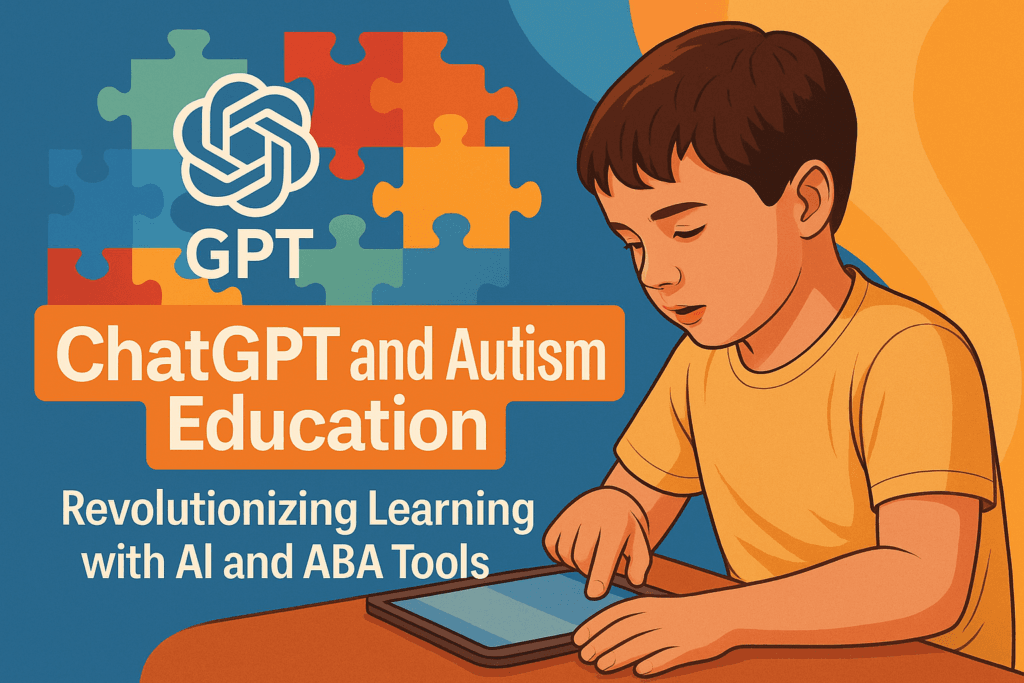🧩 Introduction: The Intersection of AI and Autism Education
In recent years, artificial intelligence (AI) has dramatically reshaped various sectors of society—from healthcare to finance. But one of the most heartening transformations is unfolding in the field of autism education, where ChatGPT and autism education now go hand-in-hand to create a more inclusive, accessible, and engaging learning environment. By integrating AI with Applied Behavior Analysis (ABA) and tech-assisted learning, we are witnessing a true revolution.
🔍 What is ChatGPT?
ChatGPT, developed by OpenAI, is a conversational AI tool that uses deep learning to simulate human-like conversations. It can:
- Answer questions 🤖
- Generate learning material 📝
- Offer emotional support 💬
- Adapt based on input from users 🧠
Its flexible, personalized nature makes it an ideal complement to the structured environment of autism therapy and education.
🎯 Why Autism Education Needs Innovation
Children and adults on the autism spectrum often struggle with:
- Traditional classroom settings 🏫
- Sensory overload 🔊💡
- Social communication challenges 🗣️
- Difficulty generalizing skills across environments 🔄
These unique challenges demand customized learning pathways, and that’s exactly where ChatGPT and autism education intersect to deliver value.
🛠️ How ChatGPT Enhances Autism Education
1. Personalized Learning Support
ChatGPT can be trained to offer custom scripts, prompts, and feedback based on a learner’s communication level, cognitive skills, and interests.
🧒 Example: A child fascinated by dinosaurs can receive math problems framed around dino-facts, increasing attention and retention.
2. 24/7 Availability
Unlike human tutors, ChatGPT is available anytime, allowing families and therapists to use it for extended or impromptu learning sessions.
⏰ Use Case: Parents can use ChatGPT at night to create the next day’s visual schedule or social story.
3. Safe Environment for Communication
AI offers a judgment-free space where autistic learners can:
- Practice conversations
- Ask questions freely
- Build confidence before interacting in real-world settings 🗣️💬
4. Interactive Role-Playing
ChatGPT can simulate social scenarios, helping learners practice responses and behaviors in a structured yet flexible format.
👫 Example: Practicing how to order food at a restaurant or respond to teasing in school.
🤝 ChatGPT and ABA Therapy Integration
ABA therapy emphasizes positive reinforcement, prompting, and task analysis. ChatGPT can be aligned with ABA methods in the following ways:
📋 Task Breakdown
ChatGPT can provide step-by-step guides or checklists for multi-step tasks like brushing teeth or completing homework.
⭐ Positive Feedback Loops
Customized praise and reinforcement phrases can be embedded into the interaction:
“Great job using your words!” or “Nice effort finishing that puzzle!”
🔄 Prompting Hierarchies
ChatGPT can be programmed to fade prompts over time, mimicking real ABA progression.
💡 ChatGPT as a Tool for Special Educators & Therapists
Educators and therapists can use ChatGPT to:
- Generate IEP goals based on behavior and academic data 📊
- Design social stories with visuals for specific behaviors or transitions 📘
- Translate complex concepts into digestible, child-friendly language 🧸
- Create customized token boards or reward systems 🎟️
🌍 Inclusivity through Multilingual Support
In multilingual communities or where English isn’t the first language, ChatGPT can be a bridge. It can:
- Translate educational content
- Maintain consistency across languages
- Support non-verbal learners with symbol/text combinations 🌐🗨️
📱 Tech-Aided Learning: Beyond ChatGPT
In addition to ChatGPT, other tech tools are reshaping autism education:
- VR tools for safe social training environments 🕶️
- AI emotion recognition for improved social cue interpretation 😃
- Voice assistants like Alexa or Siri for daily routine support ⏳
When paired with ChatGPT and autism education strategies, these tools create a holistic, tech-supported learning environment.
🧑🎓 Real-World Success Stories
🌟 Story 1: A 9-year-old non-verbal boy in India used ChatGPT-based prompts to express his food preferences, reducing tantrums and enhancing independence.
🌟 Story 2: A speech therapist in the US integrated ChatGPT into her virtual sessions, increasing engagement levels by 45% and boosting vocabulary acquisition.
📊 Research and Future Directions
Emerging studies suggest that AI tools like ChatGPT, when used ethically and alongside professional guidance, can:
- Improve communication by up to 60% 📈
- Reduce social anxiety 💬😌
- Encourage independent learning in autistic children and teens
Still, ethical considerations, data privacy, and individualization remain top priorities.
💬 Challenges & Considerations
While promising, AI in autism education isn’t without its hurdles:
- Requires adult supervision for accuracy and safety 🔐
- May not always understand sarcasm or abstract emotions 🙃
- Cultural and linguistic biases in AI training models 🧬
Hence, human involvement remains critical to guide and adapt these tools meaningfully.
🌈 A Future of Empowered Learning
With thoughtful implementation, ChatGPT and autism education could change how we perceive learning potential in autistic individuals. By blending structure, creativity, and personalization, we unlock new doors for inclusive education.
🎉 Let’s embrace this revolution—because every child deserves to learn in a way that speaks to them. 💙
🙌 Support Our Mission!
If you found this article helpful and believe in transforming autism education with technology, please support our nonprofit.
🧩 Autism Wings Inc. is building a tech-integrated school for autistic children.
🔗 Donate now:
https://secure.givelively.org/donate/autism-wings/help-build-an-autism-school-of-hope-and-empowerment
📃 We are a 501(c)(3) nonprofit. All donations are tax-deductible.

